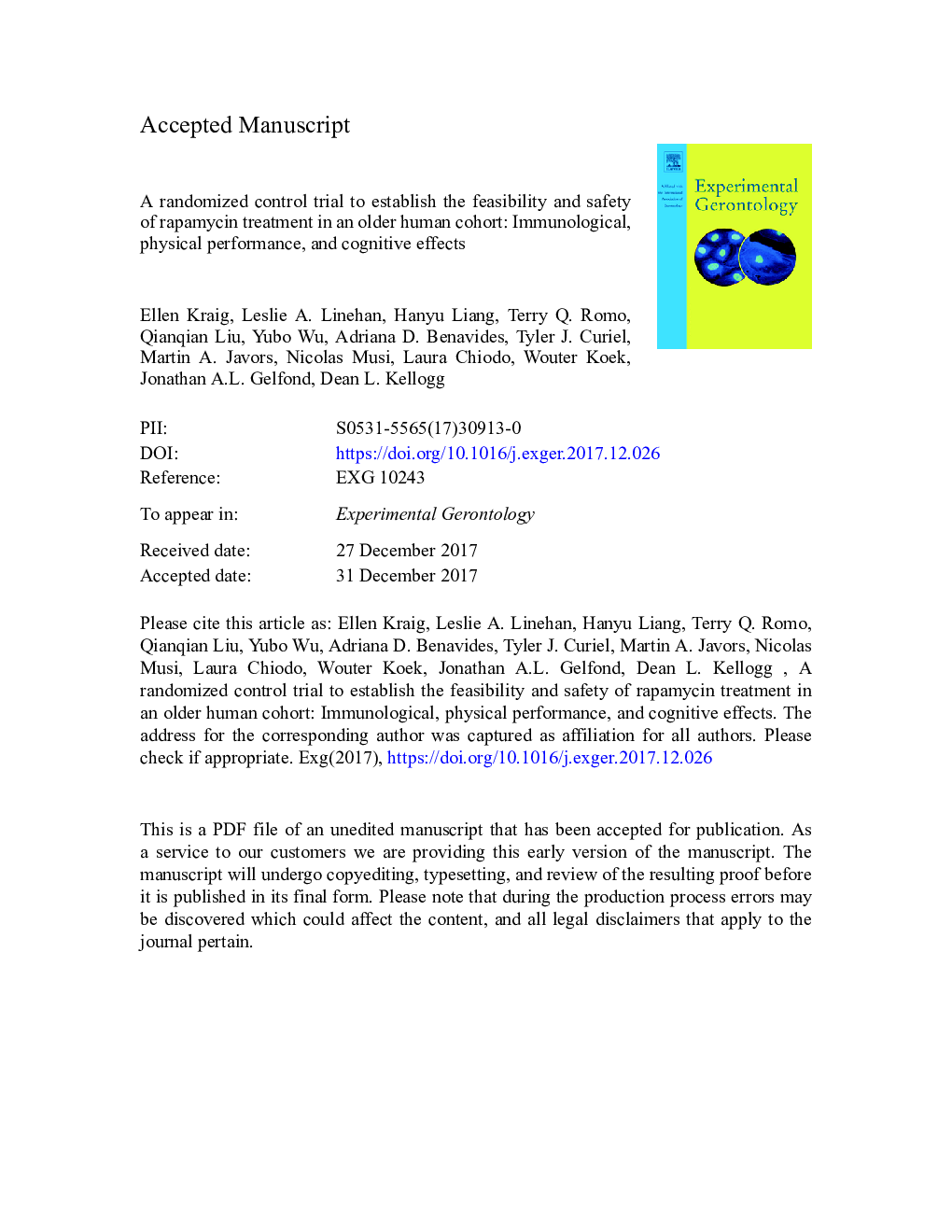| کد مقاله | کد نشریه | سال انتشار | مقاله انگلیسی | نسخه تمام متن |
|---|---|---|---|---|
| 8262416 | 1534837 | 2018 | 53 صفحه PDF | دانلود رایگان |
عنوان انگلیسی مقاله ISI
A randomized control trial to establish the feasibility and safety of rapamycin treatment in an older human cohort: Immunological, physical performance, and cognitive effects
ترجمه فارسی عنوان
یک کارآزمایی کنترل تصادفی برای ایجاد امکان پذیری و ایمنی درمان رپامایسین در گروه انسانی انسانی: عملکرد ایمنی، عملکرد فیزیکی و اثرات شناختی
دانلود مقاله + سفارش ترجمه
دانلود مقاله ISI انگلیسی
رایگان برای ایرانیان
کلمات کلیدی
CNIWBCRAPAHCTRDWRBCVLDLCMPRIAALTMCHMCVmTOR inhibitionGERDMCHCOGTTHbA1cGeriatricsmTORHCTZHDLTBILIPBSPLTsFBSTAPSPBMCCPTOral glucose tolerance test - آزمون تحمل گلوکز خوراکیAST - آسپارتات ترانس آمینازAlkaline phosphatase - آلکالین فسفاتاز یا فسفاتاز قلیاییECG - الکتروکاردیوگرام یا نوار قلبelectrocardiogram - الکتروکاردیوگرام یا نوار قلبgastroesophageal reflux disease - بیماری ریفلاکس معده به مریChronic obstructive pulmonary disease - بیماری مزمن انسدادی ریهCOPD - بیماری مزمن انسدادی ریهtrig - ترمزTriglycerides - تریگلیسریدred blood cell count - تعداد گلبولهای قرمزMean corpuscular volume - حجم متوسط مایعBUN - خوبradioimmunoassay - رادیوایمونواسیRapamycin - راپامایسینfetal bovine serum - سرم جنین گاوperipheral blood mononuclear cells - سلول های تک هسته ای خون محیطیCytokines - سیتوکین هاWhite blood cell count - شمارش گلبول های سفیدRed blood cell distribution width - عرض سلول های گلبول قرمزconfidence interval - فاصله اطمینانPhosphate buffered saline - فسفات بافر شورSlums - لاغرهاvery low density lipoprotein - لیپوپروتئین چگالی بسیار کم استLow-density lipoprotein - لیپوپروتئین کم چگالی یا الدیال LDL - لیپوپروتئین کم چگالی(کلسترول بد)High-density lipoproteins - لیپوپروتئینهای با چگالی بالاmean corpuscular hemoglobin - متوسط هموگلوبین عضلانیCalcineurin inhibitors - مهار کننده های کالسینورینblood urea nitrogen - نیتروژن اوره خونMechanistic target of rapamycin - هدف مکانیکی رپامایسینhematocrit - هماتوکریتHemoglobin - هموگلوبینHemoglobin A1c - هموگلوبین A1cHgb - هورمون رشدHydrochlorothiazide - هیدروکلروتیازیدPlatelets - پلاکت هاCreat - کراتcreatinine - کراتینینtotal bilirubin - کل بیلی روبینCalcium - کلسیم
موضوعات مرتبط
علوم زیستی و بیوفناوری
بیوشیمی، ژنتیک و زیست شناسی مولکولی
سالمندی
چکیده انگلیسی
Inhibition of the mechanistic target of rapamycin (mTOR) pathway by rapamycin (RAPA), an FDA-approved immunosuppressive drug used as a clinical therapy to prevent solid organ allograft rejection, enhances longevity in mice. Importantly, RAPA was efficacious even when initiated in relatively old animals, suggesting that mTOR inhibition could potentially slow the progression of aging-associated pathologies in older humans (Harrison et al., 2009; Miller et al., 2011). However, the safety and tolerability of RAPA in older human subjects have not yet been demonstrated. Towards this end, we undertook a placebo-controlled pilot study in 25 generally healthy older adults (aged 70-95â¯years); subjects were randomized to receive either 1â¯mg RAPA or placebo daily. Although three subjects withdrew, 11 RAPA and 14 controls completed at least 8â¯weeks of treatment and were included in the analysis. We monitored for changes that would indicate detrimental effects of RAPA treatment on metabolism, including both standard clinical laboratory assays (CBC, CMP, HbA1c) and oral glucose tolerance tests (OGTTs). We also monitored parameters typically associated with aging that could potentially be modified by RAPA; these included cognitive function which was assessed by three different tools: Executive Interview-25 (EXIT25); Saint Louis University Mental Status Exam (SLUMS); and Texas Assessment of Processing Speed (TAPS). In addition, physical performance was measured by handgrip strength and 40-foot timed walks. Lastly, changes in general parameters of healthy immune aging, including serum pro-inflammatory cytokine levels and blood cell subsets, were assessed. Five subjects reported potential adverse side effects; in the RAPA group, these were limited to facial rash (1 subject), stomatitis (1 subject) and gastrointestinal issues (2 subjects) whereas placebo treated subjects only reported stomatitis (1 subject). Although no other adverse events were reported, statistically significant decrements in several erythrocyte parameters including hemoglobin (HgB) and hematocrit (Hct) as well as in red blood cell count (RBC), red blood cell distribution width (RDW), mean corpuscular volume (MCV), and mean corpuscular hemoglobin (MCH) were observed in the RAPA-treatment group. None of these changes manifested clinically significant effects during the short duration of this study. Similarly, no changes were noted in any other clinical laboratory, cognitive, physical performance, or self-perceived health status measure over the study period. Immune parameters were largely unchanged as well, possibly due to the advanced ages of the cohort (70-93â¯years; mean age 80.5). RAPA-associated increases in a myeloid cell subset and in TREGS were detected, but changes in most other PBMC cell subsets were not statistically significant. Importantly, the OGTTs revealed no RAPA-induced change in blood glucose concentration, insulin secretion, and insulin sensitivity. Thus, based on the results of our pilot study, it appears that short-term RAPA treatment can be used safely in older persons who are otherwise healthy; a trial with a larger sample size and longer treatment duration is warranted.
ناشر
Database: Elsevier - ScienceDirect (ساینس دایرکت)
Journal: Experimental Gerontology - Volume 105, May 2018, Pages 53-69
Journal: Experimental Gerontology - Volume 105, May 2018, Pages 53-69
نویسندگان
Ellen Kraig, Leslie A. Linehan, Hanyu Liang, Terry Q. Romo, Qianqian Liu, Yubo Wu, Adriana D. Benavides, Tyler J. Curiel, Martin A. Javors, Nicolas Musi, Laura Chiodo, Wouter Koek, Jonathan A.L. Gelfond, Dean L. Jr.,
